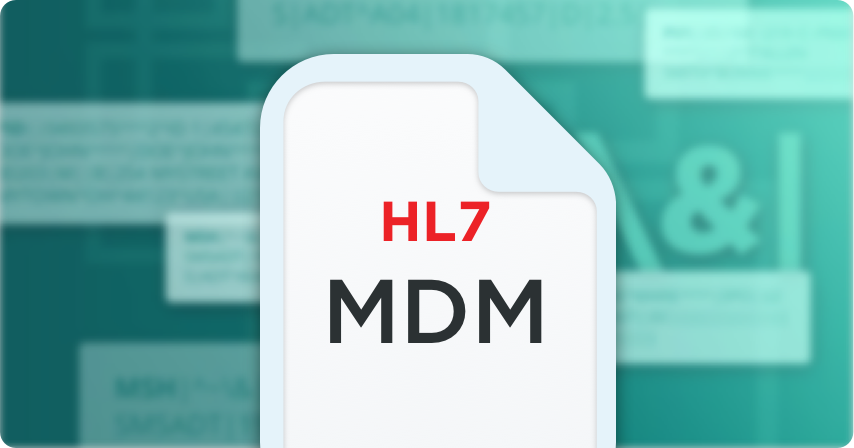
HL7 MDM
Medical Document Management
The Medical Document Management (MDM) message provides information about new or updated notes or documents.
MDM (Medical Document Management)
An MDM message can be created in relation to or independently of an order. There are 11 different MDM message trigger events. These events always include the status of the document and can also include the accompanying document itself:
- MDM^T01 - Original Document Notification
- MDM^T02 - Original Document Notification with Content
- MDM^T03 - Document Status Change Notification
- MDM^T04 - Document Status Change Notification with Content
- MDM^T05 - Document Addendum Notification
- MDM^T06 - Document Addendum Notification with Content
- MDM^T07 - Document Edit Notification
- MDM^T08 - Document Edit Notification with Content
- MDM^T09 - Document Replacement Notification
- MDM^T10 - Document Replacement Notification with Content
- MDM^T11 - Document Cancel Notification
MDM messages are typically used by Radiology departments to communicate provider transcriptions, order information and document contents. These messages either update other healthcare systems to identify available reports in the transcription system and can also provide the documents contents. The most commonly used MDM message is the MDM-T02, similar to an HL7 ORU Result Message, notifying a system of the creation of a document and providing the document contents.

Sample MDM Message
Shown below is an example of an HL7 version 2.3 MDM^T02 message:
EVN|T02|200901301235|
PID|||||DOE^JOHN||19920115|M||||||||||G83186|005729288| PV1||1|CE||||12345^WILLIS^LAYLA^H|||||||||||
TXA|1|HP^History & Physical|TX|200901151010|||||||||||||DO||AV|
OBX|1|TX|||
OBX|2|TX|||
OBX|3|TX|||
OBX|4|TX|||Name: TEST,TEST
OBX|5|TX|||MR #: 123006
TEST HOSPITAL||||||P|||||| Morrisville, Vermont 05661||||||P||||||
OBX|6|TX|||Physician:JAMES CLEA DOB:
Date:01/13/09||||||P||||||
Sex: M Age: 19
HISTORY & PHYSICAL||||||P||||||
Room #: 039A||||||P||||||
Acct. #: G8318||||||P 07/13/1989 Admit
OBX|7|TX|||Physician: KAEDING J Stay Type: I/P D/C||||||P||||||
OBX|8|TX|||Physician: KEITH P||||||P||||||
OBX|9|TX|||CC: Dizziness and weakness with elevated sugars.||||||P|||
OBX|10|TX|||HPI: This is a 19-year-old man with multiple admissions for poorly controlled||||||P||||||
| Segment | Description |
|---|---|
| MSH | Message Header. This segment is a mandatory part of an MDM message, and contains information about the message sender and receiver, the date and time that the message was created. This segment is required. |
| EVN | Event Type. Communicates the event that occurred in order for the message to be generated. This segment is a crucial part of the data flow, as it indicates where and when a message is sent based on the type of event. This is a required segment. |
| PID | Patient Identification. An MDM message is a patient-specific message type, and must be linked to a particular patient. Therefore, patient information such as the patient identifier, name, date of birth, etc. must be included in an MDM. This segment is required. |
| PV1 | Patient Visit. Contains information about patient visit details such as servicing facility, attending doctor, and visit ID. This segment is required. |
| TXA | Document Notification. Communicates information specific to a transcribed document as a result of a status change. This segment does not include the document contents and is required. |
| {OBX} | Observation Segment. Contains the document contents. This segment is required and is often repeating segments in an MDM. |
| [ ] = optional, { } = repeating | |
For more information on implementing various HL7 message types, please refer to the HL7 Messaging Standard Implementation Guides corresponding to your required version.
Working With MDM Messages
Are you working with HL7 MDM messages? In order to successfully process these messages, it's important to understand the specific format that the sending and receiving facilities are expecting the MDM messages to adhere to. Discrepancies can occur due to the version of HL7, system input error, or even simply human error when the messages were created.
How does Iguana ensure that MDM messages are properly formatted to ensure system compatibility?
Iguana is a data integration platform that allows you to easily customize the format, structure, and field values of your HL7 messages so that they are normalized, ensuring compatibility with any system you might need to interact with.
Other HL7 Message Types
- HL7 ADT (Admit, Discharge and Transfer)
- HL7 ORM (Order Entry)
- HL7 ORU (Observation Result)
- HL7 MDM (Medical Document Management)
- HL7 DFT (Detailed Financial Transactions)
- HL7 BAR (Billing Account Record)
- HL7 SIU (Scheduling Information Unsolicited)
- HL7 RDS (Pharmacy/treatment Dispense)
- HL7 RDE (Pharmacy/Treatment Encoded Order)
- HL7 ACK (Acknowledgement Message)